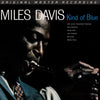





















Miles Davis - Kind of Blue (2LP, Box set, Ultra Analog, Half-speed Mastering, 45 RPM)
ORDER LIMITED TO ONE ITEM PER CUSTOMER
Miles Davis, trumpet, band leader [click here to see more vinyl featuring Miles Davis]
Julian "Cannonball" Adderley, alto sax (except on "Blue in Green")
John Coltrane, tenor sax [click here to see more vinyl featuring John Coltrane]
Paul Chambers, double bass [click here to see more vinyl featuring Paul Chambers]
Bill Evans, piano (except "Freddie Freeloader") [click here to see more vinyl featuring Bill Evans]
Wynton Kelly, piano ("Freddie Freeloader")
Jimmy Cobb, drums [click here to see other vinyl featuring Jimmy Cobb]
Written by Miles Davis
2 LPs, box set
Numbered limited edition
Original analog Master tape : YES
Half-speed Mastering
Gain 2™ Ultra Analog
Heavy Press : 180g
Record color : black
Speed : 45RPM
Size : 12”
Stereo
Studio
Record Press : RTI
Label : MOFI
Original Label : Columbia
Recorded at Columbia 30th Street Studio, New York City on March 2, 1959 (A1 to B2) and April 22, 1959 (C1 & D1)
Engineered by Fred Plaut
Produced by Irving Townsend
Remastered by Krieg Wunderlich
Originally released in 1959
Reissued in 2021
Tracks:
Side A :
1.So What
Side B :
- Freddie Freeloader
- Blue in Green
Side C :
- All Blues
Side D :
- Flamenco Sketches
Awards:
Michael Fremer's 100 Recommended All-Analog LP Reissues Worth Owning - Rated 17/100!
TAS Super LP List! Special Merit: Informal
The Absolute Sound 40th Anniversary Best Sounding Music!
Rolling Stone 500 Greatest Albums of All Time - Rated 31/500!
1000 Recordings you must hear before you die - Ranked 21
Stereophile Records To Die For - 2007
Reviews :
"Kind of Blue isn't merely an artistic highlight for Miles Davis, it's an album that towers above its peers, a record generally considered as the definitive jazz album. To be reductive, it's the Citizen Kane of jazz -- an accepted work of greatness that's innovative and entertaining. That may not mean it's the greatest jazz album ever made, but it certainly is a universally acknowledged standard of excellence. Why does Kind of Blue posses such a mystique? Perhaps it's that this music never flaunts its genius. It lures listeners in with the slow, luxurious bassline and gentle piano chords of "So What." From that moment on, the record never really changes pace -- each tune has a similar relaxed feel, as the music flows easily. Yet Kind of Blue is more than easy listening. It's the pinnacle of modal jazz -- tonality and solos build from chords, not the overall key, giving the music a subtly shifting quality. All of this doesn't quite explain why seasoned jazz fans return to this record even after they've memorized every nuance. They return because this is an exceptional band - Miles, Coltrane, Bill Evans, Cannonball Adderly, Paul Chambers, Jimmy Cobb, and Wynton Kelly -- one of the greatest in history, playing at the peak of its power. As Evans said in the original liner notes for the record, the band did not play through any of these pieces prior to recording. Davis laid out the themes and chords before the tape rolled, and then the band improvised. The end results were wondrous, filled with performances that still crackle with vitality. Few albums of any genre manage to work on so many different levels, but Kind of Blue does. It can be played as background music, yet it amply rewards close listening. It is advanced music that is extraordinarily enjoyable. It may be a stretch to say that if you don't like Kind of Blue, you don't like jazz -- but it's hard to imagine it as anything other than a cornerstone of any jazz collection." AllMusic Review by Stephen Thomas Erlewine
Ultra Analog™ : The GAIN 2 Ultra Analog™ Series stems from the use of the Gain 2 system, mastered at half speed from the original master tapes where possible, capturing and uncovering as before undiscovered sonic information.
Half-speed mastering. In half-speed mastering, the whole process is slowed down to half of the original speed. A typical 33 1/3 rpm record is cut at 16 2/3 rpm. The source material is also slowed down (reducing the pitch in the process) meaning the final record will still sound normal when played back. Slowing the whole process down allows more time, which means the end result sounds better and is more efficient — allowing engineering to minimize the effects of inherent limitations within the vinyl format. The result is a more accurate and more open high-frequency response in the half speed vinyl when compared with a normal speed recording.
Ratings :
AllMusic : 5 / 5 , Discogs : 4,75 / 5





